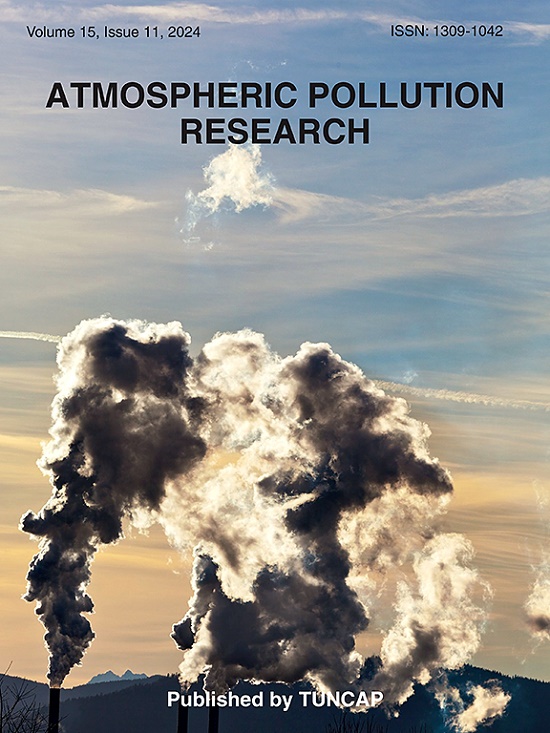Year-long variability of the mixing layer height at an urban Mediterranean location and association with air pollution levels
IF 3.5
3区 环境科学与生态学
Q2 ENVIRONMENTAL SCIENCES
引用次数: 0
Abstract
This study examines the planetary boundary layer characteristics and the association with atmospheric pollutants in Athens, aiming to assess the effects of boundary-layer dynamics on pollution levels. Ceilometer (CL31) profiles of backscatter coefficient (BSC) were used to compute the mixing layer height (MLH) based on the gradient method under cloudless conditions, revealing higher values in summer (mean: 955 m) and lower in winter (mean: 556 m). The annual mean MLH displayed a pronounced diurnal pattern depending on season with a mean value of 902 ± 337 m at noon, decreased to 525 ± 336 m at midnight. The MLH maximized at 15:00 (UTC+2) (mean: 1293 ± 337 m) closely related to surface heating and turbulent mixing conditions. MLH variations are interrelated with the local wind patterns, with stronger winds mostly from northeast directions during May–September, facilitating higher MLH and dispersion of pollutants. PM2.5, Black Carbon (BC) and NOx concentrations were strongly linked to variations of MLH, exhibiting negative correlations with it, while O3 exhibited a similar diurnal pattern with MLH (maximizing during early afternoon) due to its photochemical production and possible intrusion from upper atmospheric levels. Apart from changes in the emission sources due to domestic heating during wintertime, the shallow MLH along with stable atmospheric conditions, further exacerbate the accumulation of pollutants near the surface, with emphasis on BC. Two case studies regarding enhanced BC levels due to residential wood burning and transported smoke plumes were analyzed to assess the impacts of MLH variations on pollutant concentrations.
地中海城市地区混合层高度的年变率及其与空气污染水平的关系
本研究考察了雅典的行星边界层特征及其与大气污染物的关系,旨在评估边界层动力学对污染水平的影响。利用Ceilometer (CL31)后向散射系数(BSC)廓线在无云条件下基于梯度法计算混合层高度(MLH),结果显示夏季较高(平均值为955 m),冬季较低(平均值为556 m)。年平均MLH随季节变化有明显的日变化规律,正午平均值为902±337 m,午夜平均值为525±336 m。MLH在15:00 (UTC+2)达到最大值(平均:1293±337 m),与地表加热和湍流混合条件密切相关。MLH的变化与局地风型有关,5 - 9月强风多为东北方向,有利于MLH的升高和污染物的扩散。PM2.5、黑碳(BC)和NOx浓度与MLH的变化密切相关,呈负相关,而O3由于其光化学产物和可能来自高层大气的入侵,与MLH表现出相似的日变化模式(在下午早些时候最大)。除了冬季家庭供暖引起的排放源变化外,浅层MLH和稳定的大气条件进一步加剧了地表附近污染物的积累,重点是BC。分析了两个关于住宅木材燃烧和运输烟柱导致BC水平升高的案例研究,以评估MLH变化对污染物浓度的影响。
本文章由计算机程序翻译,如有差异,请以英文原文为准。
求助全文
约1分钟内获得全文
求助全文
来源期刊

Atmospheric Pollution Research
ENVIRONMENTAL SCIENCES-
CiteScore
8.30
自引率
6.70%
发文量
256
审稿时长
36 days
期刊介绍:
Atmospheric Pollution Research (APR) is an international journal designed for the publication of articles on air pollution. Papers should present novel experimental results, theory and modeling of air pollution on local, regional, or global scales. Areas covered are research on inorganic, organic, and persistent organic air pollutants, air quality monitoring, air quality management, atmospheric dispersion and transport, air-surface (soil, water, and vegetation) exchange of pollutants, dry and wet deposition, indoor air quality, exposure assessment, health effects, satellite measurements, natural emissions, atmospheric chemistry, greenhouse gases, and effects on climate change.
 求助内容:
求助内容: 应助结果提醒方式:
应助结果提醒方式:


